|
A legend in his own lifetime, Sam Phillips
changed the world of music in the 1950’s and created a legacy
of music for generations still to be born.
He was to discover some of the biggest names in country
music and rock 'n' roll. Sadly  Sam
Phillips died July 30th 2003 from respiratory
failure at Memphis' St. Francis Hospital. 80-year-old legendary record producer Sam Phillips was said to have
been in declining health for the past year. Sam
Phillips died July 30th 2003 from respiratory
failure at Memphis' St. Francis Hospital. 80-year-old legendary record producer Sam Phillips was said to have
been in declining health for the past year.
In January 1950 Sam opened Memphis Recording
Service, an 18 by 30 foot room at 706 Union Avenue at the
junction with Marshall Avenue. Paying a rent of $150 a month
and a ten-year lease, Phillips installed recording and transcription
equipment with a loan from Buck Turner, a performer at WREC
radio station where Phillips hosted a show "Saturday
Afternoon Tea Dance".
Born Samuel Cornelius Phillips in 1923, Sam was raised
on a three-hundred-acre tenant farm on the Tennessee River
near to Florence, Alabama. Sam was forced to leave school
in 1941 when his father died, working at a grocery store
and later at a funeral parlour. In the book "Good Rockin'
Tonight", Sam Phillips says, "I was very sensitive
to the things I heard, saw, and felt around me. You see,
back then most people died at home in the country areas
and often without a lot of warning. Those times working
with the country mortician made me very aware of how to
handle people and their problems later on".
 |
|
Sam Phillips
|
Sam Phillips started attending or took correspondence
courses in engineering, including audio engineering for
radio from the Alabama Polytechnical Institute in Auburn.
Phillips first break in radio came in 1940 when he conducted
and emceed the band for the college concert. Jim Connally
the station manager at WLAY in Muscle Shoals was so impressed
by Phillips performance that he offered him a job as an
announcer.
In 1942 Phillips married Rebecca (Becky) Burns and
they set out together on a journey that would take them to
WMSL in Decatur, Alabama, on to Nashville and WLAC and then
to Memphis where Phillips took up a position presenting the
radio show Songs Of The West on WREC, using the handle
"Pardner". Here Sam Phillips also honed his
engineering skills and in those days radio shows were often
pre-recorded onto 16-inch acetate discs and circulated to
other radio stations for broadcasting. In Good Rockin'
Tonight, Phillips states, "One of my first jobs was to
go to the Home Of The Blues record store and buy any records
that WREC weren't getting shipped to them. This went on
through the mid to late 40's. I would listen to a lot of
what was current, and I would also go play a lot of the
older records they had accumulated."
Phillips then started hosting the show Saturday
Afternoon Tea Dance and local journalist Edwin Howard
recalled, "Phillips played what he liked on that show
and talked about the records very knowledgably. He played
jazz, blues, and pop, and that was where many people in
Memphis first heard his name."
Sam Phillips opened the doors of The Memphis Recording
Studio while still  holding
down his job at WREC where he continued to present live
broadcasts of the big swing bands from the Hotel Peabody
until about 1951. A similar venture called Royal Recording
had opened in Memphis during 1948 offering the opportunity
to record private functions only to close 12 months later.
Phillips recalls, "It was because of the closures of
the Royal studio downtown that my bosses at WREC warned
me against trying to start my own recording business." holding
down his job at WREC where he continued to present live
broadcasts of the big swing bands from the Hotel Peabody
until about 1951. A similar venture called Royal Recording
had opened in Memphis during 1948 offering the opportunity
to record private functions only to close 12 months later.
Phillips recalls, "It was because of the closures of
the Royal studio downtown that my bosses at WREC warned
me against trying to start my own recording business."
For a couple of dollars anybody could go into Phillips
studio and make a demo recording. Along with lending
Phillips the money to set-up his recording studio, Buck
Turner also gave Phillips his first paying gig, recording
transcriptions of Turner's band, which were distributed to
about 15 - 20 stations around the mid-south. Using a Presto
portable tape recorder and a Presto five-input mixer board,
Phillips would load the equipment into his car and take
bookings for any social or religious event, including
weddings and funerals.
With the un-reliability of tape in those days, Phillips
would then transfer his recording on to 16-inch acetate
discs, which he cut at 78 rpm. He says in the afore mentioned
book, "Normally you wouldn't do that. You recorded
at 33 rpm on transcriptions, but in order to improve the
sound, I recorded at 78 rpm and would make an acetate master
from there." With the switch from recording on acetate
discs to magnetic tape in 1951, Phillips had to watch his
cost due to the high price of the tape and re-use every
spare inch of it.
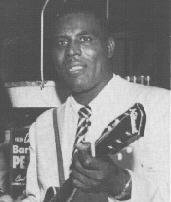 |
|
Howlin
Wolf
|
Seeing the lucrative market that the demo recordings
had led to, Phillips started Sun Record Company in the spring
of 1952. The famous logo of the silhouetted cockerel against
the sun's rays, denoted a new dawn rising....a new day in
the history of popular music. For a few hundred dollars
Phillips would cut, master, press and promote a record.
During an eight-year period Sam Phillips discovered and
recorded the likes of B.B. King, Howlin' Wolf, Ike Turner,
Rufus Thomas, Elvis Presley, Johnny Cash, Jerry Lee Lewis,
Carl Perkins, Charlie Rich, Roy Orbison and many, many more.
If you go to Memphis today, there are all the essential
sights to see. Beale Street where in the 40's &
50's the whole area was alive with blues and R&B.
 |
|
Graham
with Bernard Lancky
|
Close by is the Hotel Peabody where you mustn't miss
seeing the famous Peabody ducks that live in the penthouse
suite and come down each day to swim around the indoor
fountain. Lansky Bros Men's Shop is situated in the lobby
and 83-year-old Bernard Lansky told me that he first met
Elvis when he was admiring the cloths in Lansky's window.
Bernard invited Elvis into his shop and Elvis told Lansky
that one-day he would buy him out. Bernard Lansky replied
"don't buy me out, just buy my cloths". Elvis
did from that day on and Bernard told me that he
even supplied the suit that Elvis wore in his casket in
1977.
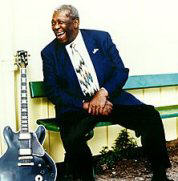 |
|
B.B.
King with "Lucille"
|
Just off Beale located in the Gibson Guitar Building,
we found the Memphis Rock 'N' Soul Museum (part of the Smithsonian
Institution), offering an interactive history with slices
of R&B, Blues and Soul music, between the 1930's and
1970's. Also exhibited are stage cloths belonging to Elvis,
Jerry Lee Lewis, Johnny Cash and B.B. King's love of his
life; "Lucille".
Sun Studio now run a free mini bus that does a
circular trip, running every hour from Beale, stopping at
The Heartbreak Hotel, Elvis's home of Graceland and finally
Sun Studio. For a few dollars you can join an escorted tour
of Sun Studio which is still a working recording studio. The
tour has been voted the best guided tour and your guide
narrates the Sun Story.
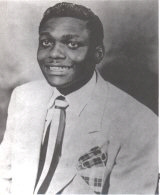 |
|
Jackie
Brenston
|
Originally Sam Phillips interest was strongly drawn
towards black, or as it was known at the time...race music...blues
and R&B. To this day Phillips says that his greatest
discovery was Howlin' Wolf. B.B. King was one of the race
artistes Phillips had been recording and he passed the word
to bandleader Ike Turner that "the market was open".
In 1951 Turner arrived in Memphis with his band the Delta
Cats, featuring the young vocalist Jackie Brenston. Guitarist
Willie Kizart's amp fell off the top of the car breaking
the speaker cone. As they couldn't get it fixed, Phillips
took a chance and over-amplified it, making a centrepiece
of the rhythm track as Kizart played a simple boogie riff
in unison with Turner's piano on a number called "Rocket
88". Released on the Chess label, Phillips later depicted
"Rocket 88" as the first rock 'n' roll record.
The record was released in April of 51, made the charts
by May and a #1 hit in June.
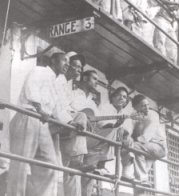 |
|
The
Prisonaires
|
The most unlikeliest of vocal groups to be recorded
by Phillips were a five-piece black singing group who called
themselves The Prisonairs. All inmates at the Tennessee
State Penitentiary in Nashville, the group was formed by
lead singer Johnny Bragg in 1943. The Prisonairs had regular
gigs at two local radio stations, WSOK and WSIX as part
of warden James Edwards' rehabilitation program. One of
the songs written by Bragg and fellow inmate, Robert Riley
was "Walking In The Rain". Phillips negotiated
for the Prisonairs to be brought to Memphis on June 1st
1953 for a recording session. The Prisonairs nailed "Walking
In The Rain" with perfection and it was released two
weeks later. Johnny Ray took the same song to #2 in the
US and #1 in the British pop charts in 1956. The writer's
first royalty cheque was for $1,400...Bragg mistook the
sum for $14 and asked the warden to deposit it in the commissary
cash register, so that he could buy some cigarettes and
candy.
 |
|
Elvis
|
Elvis Presley is by far the most acknowledged artiste
to make his debut, recording at Sun studios. For $4 you
could go into Sun and record two sides for a personal recording.
The popular myth about Elvis coming into Sun Records to
make a recording of "My Happiness" coupled with
"That's When Your Heartaches Begin" for his mother's
birthday in the summer of 53, was probably a fabrication
put out by Colonel Tom Parker years later. It is said that
Elvis's family were too poor to own a record player and
that his mother's birthday was in the spring. It is thought
that Elvis was just curious as to how he would sound on
a recording and gave the disc to a friend Ed Leek, who's
grandparents owned a record player. Presley continued to
call into Sun studio on frequent occasions over the next
year or so and made a couple more private recordings.
Marion Keisker who worked at WREC with Phillips, became
his office manager while still working part time at the
radio station. Along with Sam and his brother Jud, Marion
dealt with the day-to-day contact, nurturing the distribution
network and radio contacts that Sun Records needed, along
with the pressing plants. Phillips has often been quoted
as saying "If I could find a white boy who can sing
like a Negro I could make me a million dollars." It
is widely recounted that it was Marion who steered Phillips
towards Elvis. In July 1954 Elvis was joined by Bill Black
on bass and Scotty Moore on guitar to record two sides,
"That's All Right" with "Blue Moon Of Kentucky",
Bill Monroe's 1947 hit on the B-side. The recording was
rushed to a DJ friend of Sam's, Dewey Phillips (not related)
who hosted WHBQ's Red Hot & Blue. Dewey announced "This
is Red Hot and Blue comin' atcha from the magazine floor
of Hotel Chisca. And now we got somethin' new gonna cut
loose, cut LOOSE! Good people, this is Elvis Presley"
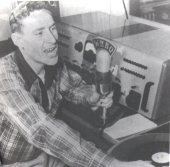 |
|
Dewey
Phillips
|
Dewey created local demand for Elvis and the phone calls
started coming in with requests for repeat plays. Dewey
conducted Presley's first on-air interview. Dewey told Memphis
writer Stanley Booth, "When the phone calls started
to come in I got hold of Elvis's daddy Vernon. He said Elvis
was at a movie down at Suzore's #2 theatre. 'Get him over
here,' I said. Before long Elvis came running in. 'Sit down,
I'm gone interview you,' I said. He said, 'Mr Phillips,
I don't know nuthin' about being interviewed.' 'Just don't
say nuthin dirty, ' I told him. He sat down and I told him
I'd let him know when I was ready to start. I had a couple
of records cued up and while they played we talked. Finally
I said, 'Alright Elvis, thank you very much.' Aren't you
gone interview me?' he asked. 'I already have,' I said,
'the mikes been open the whole time.' He broke out into
a cold sweat."
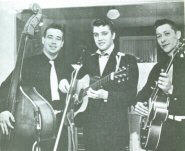 |
|
Elvis with Bill Black & Scotty Moore
|
"That's All Right" and "Blue Moon Of
Kentucky" gained local interest and Elvis's follow-up,
the R&B "Good Rockin Tonight" with "I
Don't Care If The Sun Don't Shine" on the flip side
cracked the local Memphis country charts in November 1954.
Another couple of singles made very little impression with
sales heading downward. In early 1955 Elvis recorded "Baby
Let's Play House", which was coupled with "I'm
Left, You're Right, She's Gone" kept over from the
1954 recording session. The single made #5 on the national
country charts and later that year Elvis made #1 with "I
Forgot To Remember To Forget" and the R&B number
"Mystery Train" on the B side.
Phillips was having a problem with his cash low,
distributors took batches of records, but were slow in
paying for them. Sam also owed money to his brother Jud as
part of a payout agreement. It is said that Phillips was in
debt for $25,000 and heading for bankruptcy. By October 1955
Sam finally paid off Jud with $14,000, draining the last of
Sam's cash and leaving him as the sole owner of Sun Records.
During 1955 Colonel Tom Parker came into the picture.
Parker and Canadian country singer Hank Snow formed a
company called Jamboree Attractions. Bob Neal had taken over
as Elvis's manager and he called on Parker's services as a
booking agent, who set-up a couple of tours for Presley in
February. Parker was angling to become Presley's manager and
due to his relationship with Hank Snow and Eddie Arnold (who
both recorded on RCA Victor), Parker secured a recording
contract for Presley with RCA in November. A deal was drawn
up between Parker, RCA and the music publishing company Hill
& Range to purchase Presley's contract from Sam
Phillips. Phillips received a total of $35,000 from RCA,
Parker and Hill & Range, with Elvis receiving $5,000 in
back royalties...Colonel Tom Parker took over as Elvis's
manager and as they say...the rest is all history!
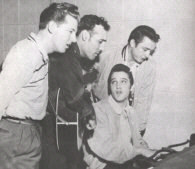 |
|
Million Dollar Quartet
|
This is not the end of Elvis's association with Sun
Records. On December 4, 1956 a recording session with Car
Perkins was winding down. Jerry Lee Lewis had been playing
piano on the session. Presley had called in and was listening
to the playbacks. They started singing and playing together
and Phillips called newspaperman Robert Johnson saying that
there might be a story and photo opportunity. Phillips also
called Johnny Cash, who was on Sun's books at that time.
Even though Presley was now signed with RCA, Phillips switched
on the mikes and recorder while the jam session took place,
with a range of country, gospel and hits of the day. The
session later came to be known as the Million Dollar Quartet
jam session.
A mix of rock 'n' roll and country music brought about
a short-lived style known as rockabilly. Johnny Cash was one
of rockabilly's first Stars. Johnny Cash lived close to Sun
Records and had been rehearsing regularly with guitarist
Luther Perkins and Marshal Grant who had just started
playing bass. He felt that they had it right and started
calling in at Sun every day asking to see Mr Phillips, but
always told he was not in yet, or he was at a meeting.
Finally Cash was waiting outside when Phillips came into
work. He said "I'm John Cash and I want you to hear me
play." Phillips invited Cash in and liked what he
heard, inviting Cash to return with his group. Their music
at that time was all religious and Phillips told Cash that
at no time could he merchandise him as a religious artiste.
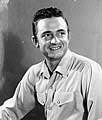 |
|
Johnny Cash
|
Cash had written "Folsom Prison Blues" which
was actually an adaptation of Gordon Jenkins tune "Crescent
City Blues". Cash recorded "Folsom Prison Blues"
and "Hey! Porter". Phillips wasn't too keen on
"Folsom Prison Blues" and Cash came up with "Cry,
Cry, Cry" which was backed with "Hey! Porter"
and released as the first single. Phillips gave Cash the
handle Johnny and named Grant and Perkins The Tennessee
Two. "Cry, Cry, Cry" made #1 on the Memphis country
charts in September and entered the national chats for one
week in November 1954.
In July 1955 rerecorded "Folsom Prison
Blues" which was backed with "So Dogone
Lonesome", but as "Cry, Cry, Cry" was still
doing well Phillips held off the release until December. In
1956 Johnny Cash and The Tennessee Two topped the country
charts for 11 weeks with "I Walk The Line".
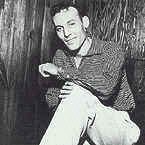 |
|
Carl Perkins
|
In 1955 Presley, Cash and Carl Perkins had briefly toured
together. Carl Perkins started a trio with his brothers
Jay and Clayton, calling themselves the Perkins Brothers
Band and in 1956 found themselves at the top of the pop
charts. "Blue Suede Shoes" has been cited to be
the first rock 'n' roll hit. In early December 1955, Carl
and his brothers had worked on the new song and in the studio
Phillips committed 3 cuts to tape. Originally the words
were "three to get ready, now go boy go"...Phillips
suggests that they change it to "go cat go" and
change "drink my corn" to "drink my liquor".
"Blue Suede Shoes" was coupled with "Honey,
Don't" and released under Carl's name in January 1956.
By February 11 "Blue Suede Shoes" has entered
the local Memphis country charts at #2. The following week
it makes #1 and by March enters the Billboard Hot 100 chart.
"Blue Suede Shoes" finally peaks at #2 on Billboard
selling 20,000 copies a day.
Barely in his twenties, Jerry Lee Lewis blew into town
and found himself outside the door of Sun Records in
November 1956. Sam Phillips offered Jerry Lee the
opportunity to show what he could do. With a hunger for
music in his eye, Jerry Lee impressed Sam Phillips enough
for him to recognise the talent that Lewis possessed. Jerry
lee Lewis's proved to be Sun's biggest seller with a
reputation that rests squarely on his Sun recordings,
amounting to just four Top Ten hits..."Whole Lotta
Shakin' Goin' On", "Great Balls Of Fire",
"Breathless" and "High School
Confidential".
 |
|
Cash,
Orbison and Lewis
|
Roy Orbison with the Teen Kings came to Sun in April
1956 to record "Ooby Dooby". In May Phillips called
them to say that the record was breaking in Memphis and
other markets and finally made #59 on Billboard Hot 100
selling around 200,000 copies. Orbison's follow-up "Rockhouse"
coupled with Johnny Cash's "You're My Baby" was
released in September. While rehearsing for a third Sun
single, "Sweet And Easy To Love" with "Devil
Doll" on the B-side, Orbison and the Teen Kings had
a falling out during rehearsals and the band broke up right
there in the studio.
Charlie Rich, Charlie Feathers and Carl Mann were less
prominent artistes who made their mark with Sun Records.
"Mona Lisa" had been a hit for Nat King Cole in
1951. Carl Mann was part of a vocal group who were at Sun
records for a recording session with another singer. When
the guy had a problem with his car, Carl Mann started
playing "Mona Lisa" on the piano. Sun's promotion
manager Cecil Scaife turned on the recording machine, but
when Sam Phillips listened to the recording, he showed very
little interest. While in town, Conway Twitty called at Sun
to see if they had anything of interest on their publishing
catalogue. He took a shine to "Mona Lisa" and put
it out on an LP and then MGM released it as part of an EP,
which drew a lot of airplay in the Midwest. Scaife had every
confidence in Mann's recoding and told Phillips that he was
going to put out a promo version at the forthcoming DJ
convention at Miami. Consequently Carl Mann's version of
"Mona Lisa" took off and peaked at #25 on the
Billboard Charts. After trying to follow-up with songs like
"Pretend", "Some Enchanted Evening" and
"The Wayward Wind", a second hit eluded Carl Mann
and his career slipped swiftly into decline.
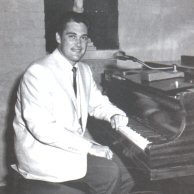 |
|
Charlie
Rich
|
Sam Phillips admits that "I don't think I ever
recorded anyone who was better as a singer, writer and player
than Charlie Rich," he says "It is all so effortless;
the way he moves from rock to country to blues to jazz."
When Rich first came to Sun arranger Bill Justis gave him
some Jerry Lee Lewis records and said, "Come back when
you can get that bad." Soon Rich was playing on sessions
at Sun. Rich was one of those artistes that Phillips didn't
know what best to do with him in the studio, so he let Rich
do whatever he wanted in the hope of capturing that little
gem that would come out of spontaneity....that touch of
serendipity. In 1960 Charlie Rich recorded his first hit
"Lonely Weekends" making #22 on Billboard. Rich
recorded 80 songs at Sun with only10 singles and one album
being released at that time.
Charlie Feathers first recorded for Sun in 1955 with
the song "Defrost Your Heart". Feathers claimed to
have co-written "Blue Moon Of Kentucky", but did
in fact co-wrote Elvis's first hit "I Forgot To
Remember To Forget" with Stan Kesler. Charlie Feathers
had a minor hit with "I've Been Deceived" coupled
with the bluegrass tinged "Peepin Eyes". His
second single was "Wedding Gown of White" which
sold fewer than 1,000 copies. Feathers recorded a rockabilly
version of the old swing number "Corrine,
Corrina", but got impatient when Phillips didn't
release the single, going over to the Meteor studio and
recorded rockabilly classics "Tongue Tied Jill"
and "Get With It."
In 1957 Sam Phillips launched a second label Sun International,
boasting offices in New York, Hollywood and Memphis, with
the label covering a wider variety of music including pop
and jazz. Unfortunately the label never really took off
due to Phillips lack of commitment to promotion and advertising
and folded in 1963. By 1958 Sam Phillips had realised that
the recording conditions at his studio on Union Avenue was
too cramped and there was a need to replace the equipment
with new multitrack recording equipment and state of the
art Neumann cutting lathes. Phillips also wanted to diversify
into custom recording by hiring out his recording studio.
New premises were found at 639 Madison Avenue and Phillips
gutted out the interior and installed two new recoding studios,
with publishing offices on the third floor. In 1960 Scotty
Moore was brought from Fernwood Records to be the studio
manager and chief cutting engineer and Charles Underwood
was hired as A&R manager and assistant engineer to join
Bill Fitzgerald (general manger) and Cecil Scaife (promotion
manager). Problems started from the very beginning; the
architect was drafted into the services...the roof leaked
so badly that Everytime it rained the mop & bucket brigade
had to turn out and the opening was delayed by 6 months.
The acoustics were poor with a hollow sound and the studio
had none of the atmosphere that had been created at 706
Union.
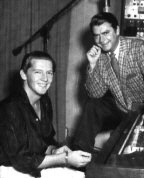 |
|
Jerry
Lee Lewis
& Sam Phillips
|
With the success of Bradley's Barn in Nashville , Phillips
decided to branch out and leased office space in the Cumberland
Lodge building for his publishing company. In the same building
Billy Sherrill and Bill Cooner had built a small recording
studio which was on the point of bankruptcy. Phillips took
it over and hired Sherrill as his engineer. Jerry Lee Lewis
made the inaugural session and cut "What'd I Say"
and Charlie Rich recorded "Who Will The Next Fool Be".
Phillip sold the studio in 1964 after being plagued by minor
problems.
The final record released by was in January 1968 by a
group dubbed Load Of Mischief. One side of the disc was
riffs from the Stax Record catalogue and the flip side was
from Motown. Sam Phillips says, "The basic reason that
Sum did not become a major label was that I preferred to
invest my time in other things. I didn't want to hook up
with a major corporation because I knew I couldn't do the
job the way I wanted to do it as part as a big company….even
though I had several offers." When Sun had stopped
releasing new product, Sam Phillips sold Sun Records to
Louisiana businessman Shelby Singleton in July 1969.
Phillips had never had any confidence in the LP market, but
during the first year since Singleton had purchased the Sun
catalogue he issued more Sun product than Phillips had in 15
years. Sam was very shroud with his money, buying radio
stations and investing in one of the biggest hotel chains in
the USA…The Holiday Inn.
The old Sun studio stood empty at 706 Union for 25
years. All the old hillbilly cats who had recorded at Sun in
the beginning, convinced Sam Phillips to restore the studio
back to it's former glory with a reunion that came to be
known as "The Class Of 55". On the Sun Studio tour
they are proud to tell you that Sun Studio is still a
working studio and that many names famous and not so famous
have recorded there; names that include Ringo Starr and
Ireland's U2.
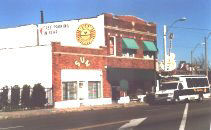 Back
on the bus which returns to each venue an hour later and
the driver Mike Freeman, who now lives in Elvis's first
Memphis home on Audubon Drive, points out Forest Hill cemetery
where Elvis and his mother Gladys were first laid to rest
and also the Baptist Memorial Hospital (which is now closed)
where he was taken after being found on his bathroom floor
in 1977. Back
on the bus which returns to each venue an hour later and
the driver Mike Freeman, who now lives in Elvis's first
Memphis home on Audubon Drive, points out Forest Hill cemetery
where Elvis and his mother Gladys were first laid to rest
and also the Baptist Memorial Hospital (which is now closed)
where he was taken after being found on his bathroom floor
in 1977.
Perhaps if there hadn't been Sam Phillips and Sun
Records, these names may never have become the
"Stars" that have shone so bright!!!
|


![]()